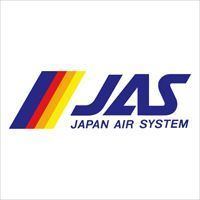JD JAS Frequent-flyer program JAS Mileage Service Date founded 15 April 1964 Fleet size 85 | JAS AIR SYSTEM Headquarters Tokyo Alliance Oneworld | |
 | ||
Focus cities Kansai International AirportNarita International Airport Hubs Haneda Airport, Itami Airport, New Chitose Airport, Fukuoka Airport, Chubu Centrair International Airport | ||
Japan Air System Co., Ltd. (JAS) (日本エアシステム, Nihon Ea Shisutemu) (IATA: JD, ICAO: JAS, Call sign: Air System) was the smallest of the big three Japanese airlines. In contrast to JAL and ANA, its international route network was very small, but its domestic network incorporated many smaller airports that were not served by the two larger airlines. As an independent company, it was last headquartered in the JAS M1 Building at Tokyo International Airport (Haneda Airport) in Ōta, Tokyo. It has since merged with Japan Airlines.
Contents
- Formation
- Start of international service
- Boeing 777 livery design contest
- Merger with Japan Airlines
- Corporate affairs
- Kant region
- Kansai region
- Chbu region
- Tohoku region
- Chugoku region
- Hokkaid
- Kysh
- Shikoku
- Ryukyu Islands
- International
- Fleet
- Credit cards
- Accidents and incidents
- Special liveries
- References
JAS was famous for its variety of aircraft liveries; Amy Chavez of The Japan Times described the rainbow liveries as "abstract." Many of its color schemes in the 1990s were designed by film director Akira Kurosawa.
The airline's slogan was "Good Speed Always".
Formation
The company was originally formed as Toa Domestic Airlines (東亜国内航空, Tōa Kokunai Kōkū) (TDA) in a merger between Toa Airways and Japan Domestic Airlines on May 15, 1971. It adopted the Japan Air System (JAS) name on April 1, 1988.
Start of international service
In 1988 Japan Air System began service from Narita to Seoul, South Korea, and by 1993 JAS was also flying to Singapore and Honolulu. In 1995 the airline had 99 domestic routes, some international routes, 64 offices in Japan, one office in Seoul, and one office in Guangzhou, People's Republic of China.
JAS entered into a partnership with Northwest Airlines in 1999 following several years of negotiations, allowing Northwest to codeshare on JAS domestic routes from Kansai Airport in Osaka and JAS to codeshare on Northwest flights between Japan and the US. On Northwest's fifth freedom flights between Japan and Asia, JAS was limited to codesharing on Northwest routes that JAS also had the authority to fly, such as Tokyo-Seoul.
Boeing 777 livery design contest
In 1996, Japan Air System held a contest for designing the livery of the Boeing 777. The youngest entrant was three years of age while the oldest was 84. A total of 10,364 participants from 42 countries submitted entries. The judges included Akira Kurosawa, Masuo Ikeda, Kenshi Hirokane, Yoshiko Sakurai, and Yusuke Kaji (梶 祐輔, Kaji Yūsuke). Thirteen-year-old Masatomo Watanabe (渡部 真丈, Watanabe Masatomo), a male second year (Grade 8) junior high school student living near Chitose Airport, won the award. The Japan Air System Boeing 777, painted in Watanabe's design, premiered in April 1997 to commemorate the 25th anniversary of Japan Air System.
Merger with Japan Airlines
JAS and Japan Airlines announced their merger in November 2001. It was the first major airline industry realignment in Japan in three decades, and partly a consequence of the slump in worldwide air traffic following the September 11, 2001 attacks in the United States. At the time, JAL had only a 25% share of the Japanese domestic air travel market, half that of rival All Nippon Airways, and saw the merger as a means of providing stronger competition to ANA domestically.
JAS and JAL prepared an integrated timetable in August 2002. On October 2, 2002, they established a new holding company, Japan Airlines System (日本航空システム, Nihon Kōkū Shisutemu), with Isao Kaneko as CEO. A new "Arc of the Sun" livery for the JAL group was announced in September 2002 and the first aircraft with the livery rolled out in November. On April 1, 2004, Japan Airlines (old JAL) changed its name to Japan Airlines International and Japan Air System (JAS) changed its name to Japan Airlines Domestic, officially ending the JAS brand.
At the time of its integration into JAL, JAS operated Airbus A300, Boeing 777, McDonnell Douglas MD-80 and McDonnell Douglas MD-90 aircraft. Most continued flying as part of the JAL fleet, but three A300s were scrapped at Sendai Airport in 2002, while two others were transferred to Fly Air in Turkey.
Corporate affairs
When Toa Domestic Airlines was originally established on May 15, 1971, its headquarters were located at the Japan Airlines Haneda Maintenance Center (羽田日本航空メンテナンスセンター Haneda Nihon Kōkū Mentanensu Sentā) at Tokyo International Airport (Haneda Airport) in Ōta, Tokyo. On February 28, 1972, its headquarters were moved to Mori Building No. 18 (第18森ビル, Dai-jūhachi Mori Biru) in Minato, Tokyo. On July 31, 1990, the headquarters moved from Mori Building No. 18 to Mori Building No. 37 (第37森ビル, Dai-sanjūshichi Mori Biru), located in Toranomon. On April 18, 1998, the head office moved to Haneda Maintenance Center 1 (羽田メンテナンスセンター1, Haneda Mentanansu Sentā, or JAS M1 Building) at Haneda Airport. On August 11, 2003, as JAS was being merged into Japan Airlines, the JAS headquarters moved from Haneda Maintenance Center 1 to the JAL Building in Shinagawa, Tokyo.
Kantō region
Kansai region
Chūbu region
Tohoku region
Chugoku region
Hokkaidō
Kyūshū
Shikoku
Ryukyu Islands
International
Fleet
Credit cards
In association with Visa, MasterCard, and Japan Credit Bureau JAS had "JAS Card" credit cards. In addition JAS had "Sky Merit" cards.
Accidents and incidents
Special liveries
Japan Air System, for a period, painted a Douglas DC-10 in a Peter Pan color scheme.
